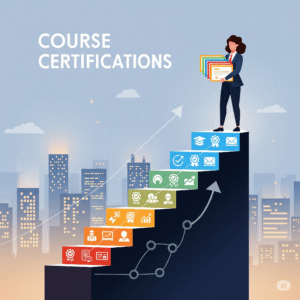Let’s face it — “building a study routine” sounds like one of those boring tasks you know you should do but would rather avoid until your next exam panic.
But here’s the truth: a solid study routine = less stress, better grades, and more free time for actual life stuff.
Whether you’re a college student juggling deadlines or a lifelong learner tackling a new skill, creating a study routine is like setting your brain on autopilot for success. And the best part? It doesn’t have to be painful, color-coded, or require waking up at 5 a.m. (unless you’re into that).
In this guide, we’ll break down how to build a study routine in 2025 — with practical tips, tools, and even a few product recommendations (affiliate links included, so you can support this site while leveling up).
🎯 Step 1: Know Your Why
Before you plan your study routine, ask yourself:
- Why are you studying?
- What’s your goal — ace exams? learn a new skill? get a certification?
Understanding your why gives your routine a purpose. Studying just to “be productive” won’t last. But studying to become a UX designer, doctor, or fluent Spanish speaker? That’s fuel.
🧩 Tool Tip: Use a journaling app like Notion or Day One to reflect on your long-term goals and track progress weekly.
⏰ Step 2: Find Your Golden Hours
Everyone has their prime brain time — the hours where focus comes easy and distractions feel irrelevant.
- Are you a morning person who loves quiet sunrise vibes?
- A night owl who thrives in the midnight silence?
Track your energy and focus for a few days and build your routine around your natural rhythm, not some internet guru’s schedule.
📱 App Suggestion: Use Toggl Track or RescueTime to monitor when you’re most focused.
📅 Step 3: Time-Block Like a Boss
Once you know your golden hours, it’s time to block out dedicated study slots. No, we don’t mean scheduling every minute of your day. Just set clear blocks of distraction-free time.
Example:
- 📘 8:00–9:00 AM – Focused Study (Reading & Notes)
- ☕ 9:00–9:15 AM – Break
- 🧠 9:15–10:00 AM – Practice Questions or Flashcards
Stick to 1–2 hour sessions max. Breaks are not optional — they’re part of the process.
📚 Pro Tip: The Pomodoro Technique (25 min study, 5 min break) works wonders. Try a timer app like Focus To-Do or grab a cute Pomodoro Timer from Amazon.
📍 Step 4: Set a Study Space You Actually Want to Be In
If your study corner is just a pile of books and yesterday’s snack wrappers, it’s not exactly motivating. Design a study setup that invites focus:
Essentials:
- 💻 A fast, reliable laptop (MacBook Air M3 or Acer Swift Go)
- 🎧 Noise-canceling headphones (Sony WH-1000XM5 = peace and quiet)
- 💡 Good lighting (try the BenQ e-Reading Lamp)
- 🪑 An ergonomic chair for those long study grinds (ErgoChair Pro)
Even adding a plant or a vision board can boost your vibe and keep you in the zone.
📓 Step 5: Choose the Right Study Methods (Not Just Re-reading)
Here’s the truth: how you study matters more than how long you study.
Switch up passive reading with active techniques like:
- ✍️ Active Recall: Quiz yourself regularly.
- 🔁 Spaced Repetition: Review material over increasing intervals (use Anki or Quizlet).
- 🧠 Feynman Technique: Teach the concept as if explaining it to a 5-year-old.
💡 Book Plug: Want to master learning itself? Grab Make It Stick — it’s the ultimate study-science bible.
📆 Step 6: Create a Weekly Study Plan
It’s easy to wing it… until it’s Sunday night and you’ve done nothing. Use a weekly study planner to map out:
- 🎯 Your priorities
- 📘 What subjects or skills to cover each day
- 🎓 Any deadlines or upcoming tests
Stick to 3–4 main study goals per week. That’s enough to build progress without burning out.
📱 Tool Suggestion: Try a digital planner like Notion, or go analog with a cute study planner notebook.
📈 Step 7: Track Progress & Celebrate Wins
We’re wired for rewards. Seeing your progress builds motivation — and helps you keep going.
Track things like:
- Chapters completed
- Practice test scores
- Study streaks
Celebrate small wins with mini rewards: Netflix episode? Coffee date? 20 minutes of guilt-free TikTok scrolling? Go for it!
📊 App to Try: Habitica turns study goals into a fun RPG game. You level up by completing tasks!
🚨 Step 8: Be Flexible (Perfection Is the Enemy)
Real talk: you won’t stick to your routine 100% of the time. Life happens. Don’t let one missed session ruin your momentum.
Instead:
- Adjust your plan weekly
- Reflect on what’s working and what’s not
- Focus on consistency, not perfection
📘 Recommended Read: Atomic Habits by James Clear — perfect for building routines that stick.
🎁 Bonus: Must-Have Tools for Study Routine Success (with Affiliate Links)
| Tool | Why It’s Great | Link |
|---|---|---|
| 🎧 Sony WH-1000XM5 | Ultimate focus with noise canceling | Buy Here |
| ⏲️ Pomodoro Timer | Boosts productivity in bursts | Shop Now |
| 💻 MacBook Air M3 | Fast, light, and reliable | Check Deals |
| 📒 Notion | All-in-one planner, tracker & notes | Try for Free |
| 💡 BenQ Lamp | Eye-friendly lighting | Buy Here |
| 🪑 ErgoChair Pro | Posture support for long sessions | See Price |
✅ Final Thoughts: Your Study Routine = Your Superpower
A good study routine isn’t about grinding 12 hours a day or turning into a robot. It’s about creating a sustainable system that helps you learn smarter, stay motivated, and still have a life.
Remember:
- Know your why
- Study during your peak hours
- Use the right tools and techniques
- Be consistent — but stay flexible
And most importantly: make it your own. Because your brain, your goals, and your life deserve a study routine that works with you, not against you.
Happy studying! 🎓




